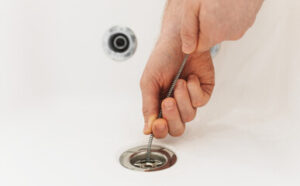Drains that are kept clean whisk away wastewater instead of standing water. They also operate more smoothly and efficiently than clogged ones.

The first thing a professional drain cleaning service will do is look at your pipes and identify the cause of the clog. They can then use a variety of techniques to remove it. Contact Drain Cleaning Aurora, CO for professional help.
Chemical drain cleaners are pure or mixed products used to dissolve hair, food scraps and other organic materials that clog drains. They come in liquid, gel or powder form and are available at most hardware, home improvement and big box stores. They are often marketed as quick, easy solutions to blocked drains and may offer some success with simple, relatively harmless clogs.
Most chemical drain cleaners work by creating a reaction with the materials that make up the clog. Some of these cleaners are caustic, meaning they create heat or break down the clog material by combining with it to form a new substance. Others use strong acids to dissolve materials, either by oxidizing them or dissolving them.
Liquid chemical drain cleaners are poured into the blocked drain and left to work for a few minutes before being flushed with water. When using these products, it is important to follow the instructions on the label regarding how long to wait before flushing the drain with hot water. Overuse of these cleaners can damage your pipes, so it is a good idea to only use them a few times per year at most.
Many chemical cleaners are marketed as being effective against a wide variety of clogs, from food to hair and even grease. However, they usually only remove a portion of the clog and may not be able to dissolve more stubborn substances like grease or congealed hair. They also put your pipes at risk for corrosion, as they can eat through the metal of your pipes over time.
The strong chemicals in these cleaners can also be harmful to your health. If you get these cleaners on your skin or inhale them, they can irritate your nose, throat and lungs. In severe cases, they can cause burns and even blindness. When they seep into the groundwater or soil, they can also be toxic to plants and animals that drink or bathe in the contaminated water. For these reasons, it is important to always wear protective gear when using chemical drain cleaners.
Bio-Active Enzymatic Foam Cleaners
While caustic drain cleaners are effective for unclogging severe clogs, they can damage pipes and pose a risk of chemical burns. Bio-active enzyme foam cleaners offer a more natural and safer alternative, removing organic material that causes blocked drains and odors. Bio-enzymatic cleaners use a mix of bacteria and bio-chemicals that break down and digest organic waste. These products work on a wide range of soils, including food particles and grease, while remaining safe for drain lines and septic systems.
Enzymatic cleaners also have the added benefit of promoting good bacteria growth in facilities. These non-pathogenic microorganisms help displace pathogenic bacteria that can cause disease. As a result, these products are often safer for both employees and visitors than conventional cleaning chemicals.
Many different types of bio-enzymatic cleaners are available, depending on the type of soil that needs to be removed. For example, some cleaners have cellulose enzymes that break down paper and cardboard, while others contain proteases that break down protein-based stains. Other ingredients may include lipases, which breaks down fat molecules and helps remove oily residues.
Bio-enzymatic cleaners are usually applied like regular detergents, with a sponge or cloth soaked in the solution. Then, the soiled surface is wiped down until it is clean and free of odors and residue. The cleaners remain active on surfaces for days, keeping restrooms and other high traffic areas fresh and smelling clean.
Custodial managers should note that these types of cleaners typically take longer to work than caustic chemicals, because the bio-chemicals need time to react with the odor and stain-causing materials. Therefore, they should apply the product during a slow period in the facility, such as after hours or on weekends.
For example, Nyco’s Arrest Uric Acid Eliminator is a powerful yet safe restroom odor eliminator that uses a blend of live enzyme cultures to actively breakdown and absorb organic matter and eliminate uric acid stains and odors. It can be applied to hard-to-reach crevices in toilets and urinals, as well as floors and other restroom surfaces. It also offers a residual effect, which means it continues to work for days after application to prevent future odors from occurring.
Plungers
One of the most basic tools in a plumber’s toolbox is the plunger. The shape of a plunger’s rubber cup creates an airtight seal over sinks, tub drains, and toilets, and the thrusting action of the handle breaks up and removes clogs. A plunger does not contain chemicals and is a much safer option than chemical drain cleaners, which can damage pipes and other plumbing fixtures in your home.
There are different kinds of plungers, and they work differently depending on how you use them. Some plungers have long handles designed to fit underneath faucets, while others are short and ideal for toilets and waist-high drains. The handle of a plunger can also be made from plastic, wood or metal, and many have ergonomic designs to provide a better grip and allow both hands to maneuver the plunger.
Cup-style plungers are the type most often used at home, and they’re ideal for sinks, tubs and shower drains. The head of a cup-style plunger is flat, and it works best on relatively flat surfaces. These plungers are also available with flanged heads that create a more secure seal on toilets and some floor drains, and with tiered or beehive-shaped heads that can clear clogs in showers and bathtubs.
To use a plunger, position it over the clogged drain and push down with all your strength. Hold the plunger at a 90-degree angle, and repeat the process of pushing down and then pulling up to loosen and remove the clog. When you’re done, be sure to clean the plunger and store it properly.
A clogged drain can be caused by a wide variety of things, from food scraps to grease and other solid debris. If a plunger doesn’t help, it may be time to try a plastic drain snake. This wire-like device reaches through plumbing to grab and break apart clogs, and it can be rented from most big box stores.
If you can’t get a clog to loosen with a plunger or a plastic drain snake, call a professional plumber. A plumber can inspect your pipes and determine what might be causing the clog. It could be an issue in your S-trap or P-trap, which are serpentine sections that prevent odourous sewer gas from escaping into the home, or it might be a blockage in your home’s plumbing venting system.
Wire Hangers
Like most Americans, you probably have a treasure trove of wire hangers sitting around waiting for trash day. They’re often covered with a plastic coating and may also contain metal clips or a hook at the end that makes it easier to grip garments. Wire hangers are made from a galvanized steel wire, which protects the metal from rust and corrosion.
They can be used for a variety of purposes and serve as an inexpensive, environmentally friendly alternative to more expensive options like wooden hangers or clothespins. They’re particularly useful for hanging delicate fabrics like silk or satin, which can snag and damage when hung with ordinary metal hangers. Some varieties of these hangers are designed to be lightweight, while others are more rugged and sturdy. The coating on these hangers helps keep them looking good and provides an extra layer of protection from tarnishing, which can help maintain the shape of garments hung on them.
While metal is usually the primary material for coat hangers, some varieties are available in other materials, such as aluminum or copper alloys. These alternative metals have a lighter weight and are less likely to rust, which makes them desirable for environments where weight is a consideration. They’re also more resilient than steel wire, so they can be formed into more intricate shapes without risk of stress cracking or shattering.
Coat hangers are often shaped to make them more useful, such as by forming them into a circular shape or creating a handle. This allows them to be used for a number of purposes, including hanging clothing and other household items, making a scrap fabric wreath, or holding a pair of scissors or a wrench. They can also be snipped to form small loops that can be used as safety pins.
Despite their versatility, however, there are some drawbacks to using wire hangers. One is that they’re not always easy to dispose of in a way that doesn’t harm the environment. Even though they can be recycled, they tend to get caught in recycling equipment and cause machinery jams that can damage and delay the process. Some dry cleaners are willing to accept old wire hangers for re-use, and companies like Pennsylvania’s Allied Services have collected, cleaned and re-circulated millions of them, but most people still throw away a substantial number each year.
